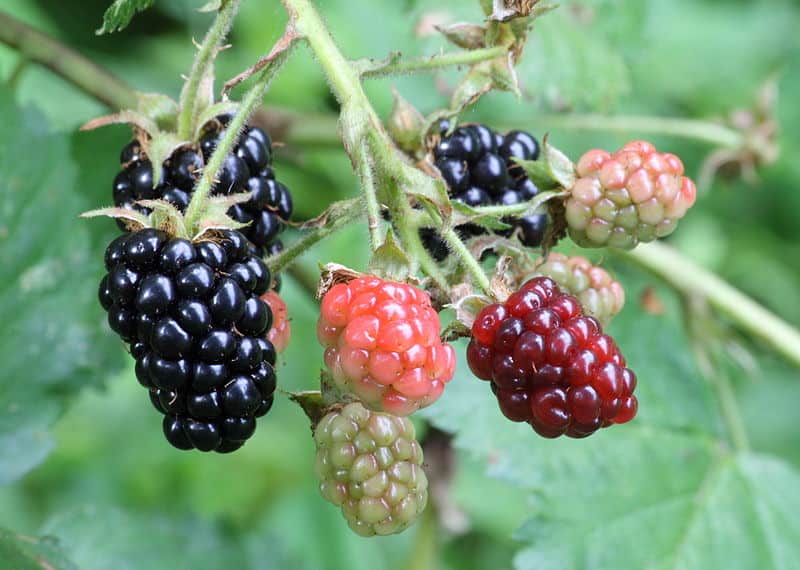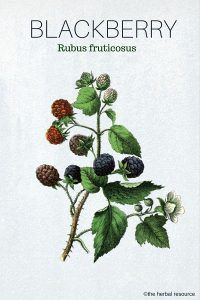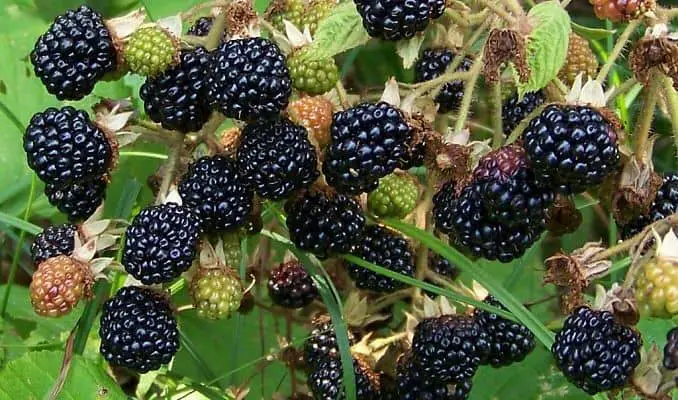Botanical Name: Rubus fruticosus L. coll.
The blackberry plant is capable of germinating seeds without pollination (apomictic propagation) and due to this ability, it has given rise to many apomictic micro species that can be very difficult to distinguish from each other.
In herbal medicine, the blackberries are considered one species and have the scientific name Rubus fruticosus coll, where “coll.” stands for “many apomictic micro species”.
Other Common Names: Bramble, dewberry, gout berry, björnbär (Swedish), ronces (French), Brombeere (German), zarza (Spanish), brómber (Icelandic).
Habitat: The plant is endemic to the temperate parts of Europe, West Asia, and North Africa but has naturalized in America, Australia and many other countries around the world.
Description: Rubus fruticosus is a half-shrub of the Rosaceae family that can reach up to 3 meters tall.
It has erect curved branches that can easily produce roots when they’re touching the soil. The stems are rough, angular with rough thorns that become woody as they age.
The leaves are green with usually five or seven lobes.
The blackberry blossoms from June to August with white or pink flowers that have outspread petals that are longer than the sepals. The fruits are shiny blue-black to black red when they’re mature. The taste is sweet, aromatic and more or less astringent.
Plant Parts Used: The leaves, root and berries.

Therapeutic Uses, Benefits and Claims of Blackberry
The leaves contain triterpenes, flavonoids, saponins, vitamin C, organic acids, traces of essential oil, arbutin, hydroquinone and a high concentration of tannins.
The fully ripe fruits contain organic acids, sugar compounds, anthocyanins, pectin, niacin, flavonoids, mucous substances, carotenoids, vitamin C and several B vitamins.
The leaves, roots and root bark are used medicinally, while the fruits are mainly used for culinary purposes.
The astringent (constricting) effect of the leaves has been known for a long time, and writers of ancient herbal literature such as Hippocrates, Dioscorides and Pliny recommended them as herbal medicine.
The blackberry leaves, root bark and roots contain relatively large amounts of tannins with astringent properties and have been used internally as herbal remedies to treat digestive ailments such as diarrhea, dysentery and gastroenteritis.
Traditional uses also include the treatment of illnesses and ailments such as bleeding, slow healing wounds, fever, inflammation, cystitis, gout, infertility, vaginal discharge, flu,colds and cough.
Externally the blackberry leaves have been used to treat eczema and other rashes, acne, oily skin, injuries, hemorrhoids, fungal infections and pain and itch of insect bites and stings.
An extract made from leaves can be used as a gargle for inflammation of the mouth and throat, mouth ulcers, gum inflammation and a sore throat.
The fully ripe fruits of the blackberry can be eaten raw or cooked or used for juice, jams, liqueurs, and wines. The taste is strong and aromatic, but can vary slightly from one apomictic micro species to another.
The blackberries are high in vitamin C and sugar compounds and were therefore eaten in the past to treat scurvy.
There is some thought the berries are useful in increasing levels of red blood cells and may benefit those suffering from anemia.
The berries have a high content of antioxidants and could have a protective effect against some types of cancer.
Due to the content of organic acids and pectin, the ripe blackberries have a mild laxative effect but the immature berries contain relatively large amounts of tannins and therefore have an opposite effect.
Dosage and Administration
A tea can be made from 1 to 2 tablespoons of dried blackberry leaves in one cup of boiling water.
Steep for about 10 to 15 minutes before it’s strained.
The tea can be drunk several times a day, preferably between meals.
Possible Side Effects and Interactions of Blackberry
A moderate intake of the ripe berries has no known side effects, but excessive amounts can cause diarrhea while the immature berries can cause constipation.
Due to the high content of tannins found in the herb it can cause nausea and vomiting in some people.
Other Resources on Blackberry
Plants For A Future – Rubus fruticosus – L.
Supporting References
Volák, Jan & Jiri Stodola: The Illustrated Book of Herbs. London. Caxton Editions 1998.
Bown, Deni: The Royal Horticultural Society New Encyclopedia of Herbs & Their Uses. London, Dorling Kindersley 2002.
Stuart, Malcolm: The Encyclopedia of Herbs and Herbalism. London, Orbis Publishing 1979.
Cunningham, Scott: Cunningham’s Encyclopedia of Magical Herbs. St. Paul, Minnesota. Llewellyn Publications 2000.
Mars, Brigitte: The Desktop Guide to Herbal Medicine. Laguna Beach, California. Basic Healh Publications 2007.
Thordur Sturluson
Latest posts by Thordur Sturluson (see all)
- What is the Difference Between Hemp and Marijuana? - June 3, 2019


Leave a Reply